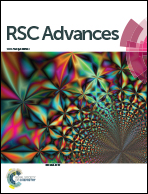Pt decorated Artocarpus heterophyllus seed derived carbon as an anode catalyst for DMFC application†
Abstract
A carbohydrate rich Artocarpus heterophyllus seed (AHS) is processed via a hydrothermal carbonization method (HTC) for various reaction times (12, 18, 24 and 30 h) and further thermally carbonized at 700 °C under N2 atmosphere to sequester a high surface area carbon. Subsequently, Pt NPs are also decorated on the prepared carbon and this was used as an anode catalyst for a methanol oxidation reaction (MOR). The XRD and Raman spectra showed the as-synthesized material has a typical graphitic structure of carbon and an fcc structure of platinum with a grain size smaller than 3–4 nm. The presence of functional groups including –OH, –C![[double bond, length as m-dash]](https://www.rsc.org/images/entities/char_e001.gif) O and –C–O are identified along with some heteroatoms on the surface of carbon through Fourier transform infrared (FT-IR) spectroscopy. X-ray photoelectron spectroscopy analysis exposed the presence of expected species such as C 1s, O 1s, N 1s and Pt 4f. Moreover, BET analysis of the spherical hydrochar carbonized at 700 °C showed a surface area of 431.5 m2 g−1 with a mean pore diameter of 3.2 nm and a pore volume of 0.354 cm3 g−1. Morphological analysis such as Field Emission Scanning Electron Microscopy (FE-SEM) and Transmission Electron Microscopy (TEM) images revealed the spherical nature of the obtained hydrochar as well as its transformation into an agglomerated network after carbonization at 700 °C. The obtained Pt loaded carbon showed an excellent electrocatalytic activity in the potential range of interest with a high ECSA of 261.4 m2 g−1 for Pt/C (hydrochar formed during 24 h and carbonized at 700 °C). Moreover, the Pt decorated optimized carbon sample has much higher peak current and mass activity of about 0.32 mA mg−1 and 54.4 A g−1 towards MOR. In addition, chronoamperometry analysis also exposed a good stability over 10 000 s. It is also legitimated that a 20 : 80 wt% of Pt/C loading shows a high current density with no relevant change in the onset potential and long-term stability during MOR with a few comparable results.
O and –C–O are identified along with some heteroatoms on the surface of carbon through Fourier transform infrared (FT-IR) spectroscopy. X-ray photoelectron spectroscopy analysis exposed the presence of expected species such as C 1s, O 1s, N 1s and Pt 4f. Moreover, BET analysis of the spherical hydrochar carbonized at 700 °C showed a surface area of 431.5 m2 g−1 with a mean pore diameter of 3.2 nm and a pore volume of 0.354 cm3 g−1. Morphological analysis such as Field Emission Scanning Electron Microscopy (FE-SEM) and Transmission Electron Microscopy (TEM) images revealed the spherical nature of the obtained hydrochar as well as its transformation into an agglomerated network after carbonization at 700 °C. The obtained Pt loaded carbon showed an excellent electrocatalytic activity in the potential range of interest with a high ECSA of 261.4 m2 g−1 for Pt/C (hydrochar formed during 24 h and carbonized at 700 °C). Moreover, the Pt decorated optimized carbon sample has much higher peak current and mass activity of about 0.32 mA mg−1 and 54.4 A g−1 towards MOR. In addition, chronoamperometry analysis also exposed a good stability over 10 000 s. It is also legitimated that a 20 : 80 wt% of Pt/C loading shows a high current density with no relevant change in the onset potential and long-term stability during MOR with a few comparable results.


 Please wait while we load your content...
Please wait while we load your content...